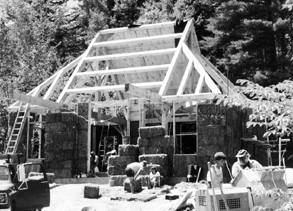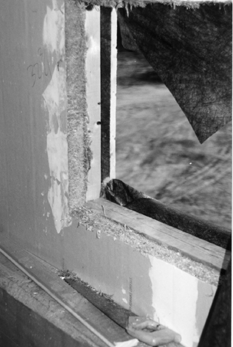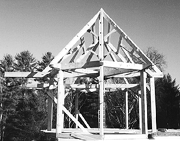


1996 was a virtual metamorphosis at Fox Maple School of Traditional Building. Three new buildings, all different in design and materials, comprise the beginning of a dynamic testing facility for natural building materials and systems. We found that while the cost of materials like clay, woodchip and straw are negligible, building with them is labor intensive. In order to make building with natural materials more practical, we need to create new systems which balance the labor to materials equation in a way which is cost-effective and builder-friendly. While it is fun to get twenty friends together to stack straw bales, most contractors work with crews of three to four people. "Sustainable" building has to advance beyond concept and theory into workable systems whereby any builder can do it.
Finding the right equipment for the job led to many small steps we'd recommend to improve efficiency in working with straw and clay. An old-fashioned shredder with dull, flat, square tines, made shredding and chopping straw manageable, but produced too much dust when used to break up clay. Brickyards use a roller machine to prepare clay; labor costs could be reduced by getting clay delivered to the site already in fine powder form. Using a sprayer vastly increased the efficiency of applying the light-straw/clay finish coat used on both the straw-bale house, and the straw-panel house built last summer. Due to the thickness of the plaster required to cover the uneven surface of straw bales, developing a more mechanized mixing and delivery system seems to be the key to making it practical and cost effective
 Ideally, standard
sized and R-factor rated panels will soon be available to builders as the
most versatile and usable form in which to use straw. The uniform surface
of panelized straw can be treated like any wallboard, and takes a sprayed-on
clay finish easily. The goal for the coming year here is to work out reasonable,
cost-effective systems with a viable ratio of materials to labor costs.
This by no means excludes the owner from the process.
Ideally, standard
sized and R-factor rated panels will soon be available to builders as the
most versatile and usable form in which to use straw. The uniform surface
of panelized straw can be treated like any wallboard, and takes a sprayed-on
clay finish easily. The goal for the coming year here is to work out reasonable,
cost-effective systems with a viable ratio of materials to labor costs.
This by no means excludes the owner from the process.
One of the obstacles to the use of new materials is the shipping involved in obtaining new products that are not distributed widely. When ordered on a per-job basis, builders pay a premium for trucking small quantities. We would like to foster a community approach to building, getting people together to obtain equipment, share professional consultants, and purchase materials in bulk. A clearinghouse to help people source both materials, and professionals to help with the planning, design, and building process, would be of benefit to the sustainable market.
The plan is to continue to explore new materials in workshops here, and in the process to figure out the most efficient way to use each material, and which materials are best suited to which applications. We will address four systems specifically in 1997: wattle and daub, woodchips and clay, light straw/clay, and straw/clay blocks.
The true test of any system is in building real houses for real people. In addition to our structured workshops, we plan to build 2-3 demonstration projects through the Apprenticeshop this year to further develop systems that work on-site.
With the increasing interest in Bau-biologie, green architecture, and healthy environments in which to live and work, there is no reason why everybody should not be building with natural, renewable materials. Entry into the mainstream, however, can only happen if viable, efficient and proven systems-adaptable to a variety of building scenarios-can be worked out. In an effort toward this end, Fox Maple School is starting a referral network of professional consultants that can work with people to build natural houses. Please contact us to add your specialty to the network.
 BackThe
Edible House Bakery frame, cut in the September workshop at Fox Maple,
was erected in Canterbury,
BackThe
Edible House Bakery frame, cut in the September workshop at Fox Maple,
was erected in Canterbury,  N.H.
this fall. The bakery will ultimately incorporate as many natural materials
as there are ingredients in the baker's bread. Strawbale infill was the
baker's choice of enclosure system for the octagonal timber frame: the
same grain fiber that forms the bakery's bread would form its walls. However,
actual site conditions dictated a change in plan.
N.H.
this fall. The bakery will ultimately incorporate as many natural materials
as there are ingredients in the baker's bread. Strawbale infill was the
baker's choice of enclosure system for the octagonal timber frame: the
same grain fiber that forms the bakery's bread would form its walls. However,
actual site conditions dictated a change in plan.
Initially, it was determined that a slab on grade or rubble foundation would be the least costly way to achieve the 18" pad straw bales would require. A rubble foundation consisting of a twenty-inch to four foot deep trench filled with crushed stone, would seat a concrete footing poured on top, or a course of quarried NH granite for a stone footing.(When constructing outbuildings, sills can be laid directly on a crushed stone bed.)
The bakery site features a south-facing grade, which the owner wanted to take advantage of with a partially open, light-filled basement. Preparing the foundation to accept strawbales would increase the overall cost considerably, because a three-step excavating, pouring, and back filling process would be required to accommodate an 18" foundation cap on which to seat the bales.
 These implications
led to a decision to discard the notion of a strawbale enclosure system.
A woodchip and clay infill system would be used instead, on a standard
eight inch foundation.
These implications
led to a decision to discard the notion of a strawbale enclosure system.
A woodchip and clay infill system would be used instead, on a standard
eight inch foundation.
Woodchips are more readily obtained locally than straw, and are less expensive. Additionally, woodchips require none of the prep work-shredding and chopping-that a straw and clay infill would.
To enclose the building, slip-forms are attached to the frame and packed with a mixture of woodchips and clay that is easily prepared on-site with a simple mixer. We would like to persuade a concrete mixing truck to try woodchips and clay. This could be a great way to increase the efficiency of filling wall forms. It would flush out easily after pouring, and there is nothing in the mix that would interfere with the next concrete job.
On a humorous note, the lumber supplier, when apprised of the original reason for specifying strawbale infill, exclaimed that he sells his purest all-natural sawdust to a baker who incorporates it into a high-fiber specialty bread! So, despite the reworking of the design, the Edible House Bakery remains true to its original intent. To Beginning of file